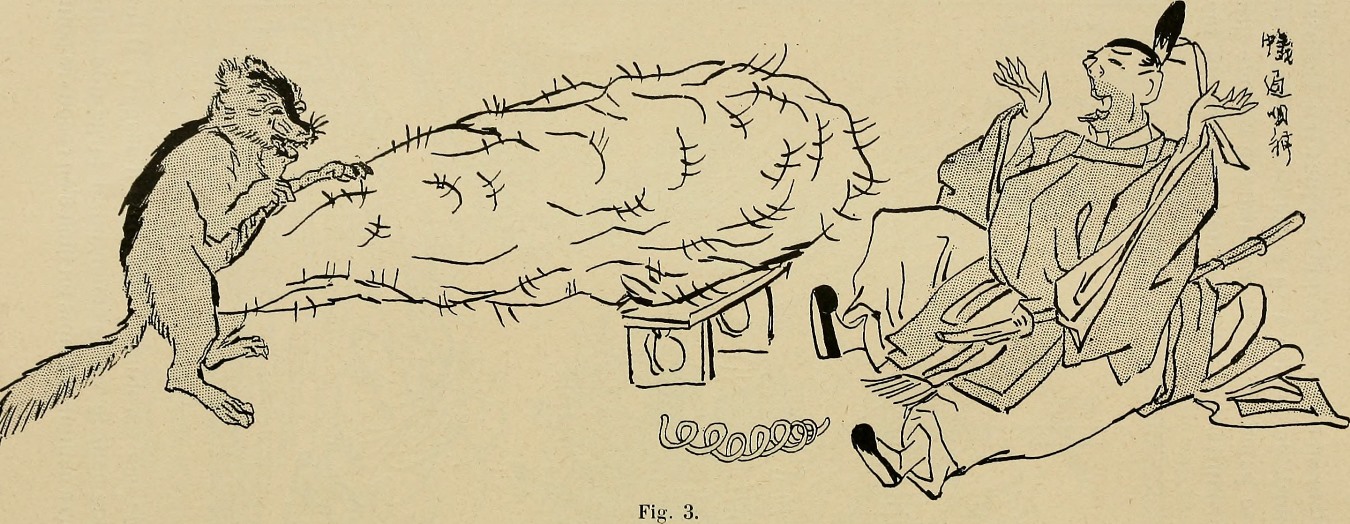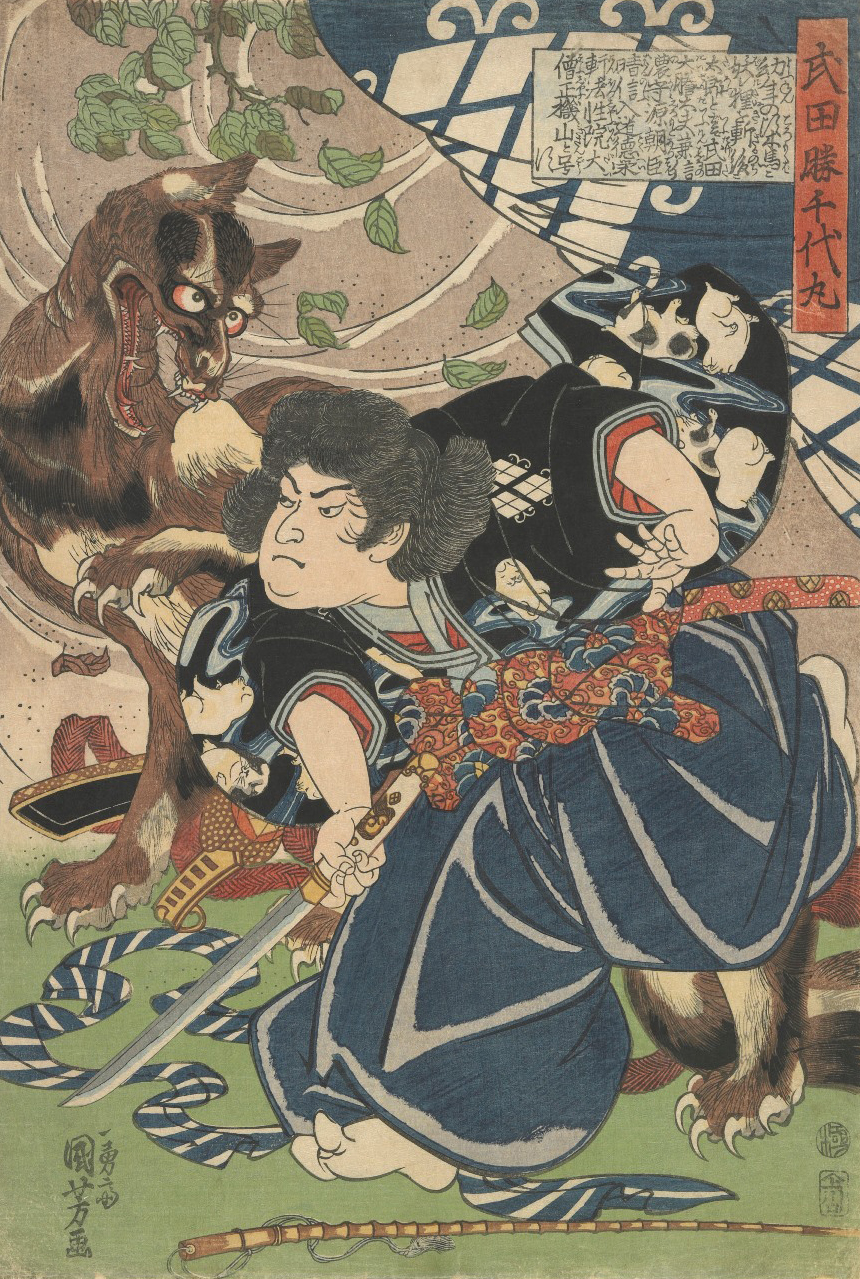Raccoon dogs and raccoon dog products are in use for medical purpose in many countries across the Indian ocean. Stories about this animal were gathered and written by students. They are all part of a pedagogical project, funded by the National University of Singapore and the Université de Paris. The Bestiary site is a work-in-progress and a participatory educational tool, representing animals whose products or body parts are used to promote health and healing.
Tanuki The Legendary
A Story by Ong Ghim Hwee Claire
The Japanese raccoon dog, more commonly known as Tanuki, has a long history in Japanese folklore. In Japan, there are many legends of Tanuki and they represent a traditional Japanese prankster god. They are often compared to the Kitsune (fox), and are supposedly superior in disguises, but unlike the Kitsune that changes its form to tempt people, Tanuki do so to fool people and make them seem stupid. In these legends, Tanukis are shape-shifters and their testicles play an important role in their shape-shifting. They have been known to use their testicles as makeshift raincoats, weapons and drums. They knead their testicles into the shape they desire and impersonate humans to buy alcohol and delicacies. The myths and legends surrounding Tanukis are so common in Japan that it is even featured in traditional Japanese children’s songs. The legendary Tanuki has eight special traits that bring good fortune: a hat to be ready to protect against trouble or bad weather, big eyes to perceive the environment and help make good decisions, a sake bottle that represents virtue, a big tail that provides steadiness and strength, an oversized scrotum that symbolizes financial luck, a promissory note that represents trust or confidence, a big belly that symbolizes bold and calm decisiveness, and a friendly smile. Unlike the Kitsune which is familiar throughout the world and maintains an aura of danger and mysteriousness, the Tanuki is unique to Japan and seen in a very positive light as a mischief-maker. In modern Japan, the most common manifestation of the Tanuki is entirely positive and statues of it can be seen throughout Japan mostly outside shops or used as mascots as people see it as a commercial good-luck figure.
Scientifically, the Tanuki is a potentially hazardous invasive species. Invasive wildlife species are known to have the potential to act as additional host and vector species for infectious disease. The Tanuki, was one of those studied to demonstrate biological and ecological prerequisites which enabled invasive species to occupy a new habitat permanently. Studies conducted over 20 years have identified 35 species of endoparasites, five ectoparasites, six bacterial or protozoan species and five viruses in one of the Tanuki subspecies studied. Studies from Finland and Germany also showed that the biological characteristics of the Tanuki makes it an ideal host and vector for a variety of pathogens, which might have potentially adverse effects on human and animal health in the livestock sector, especially with regard to its potential as a reservoir for zoonotic diseases. Hence scientifically, the Tanuki is being highlighted as an animal that should receive more attention in disease prevention and eradication strategies.
Some notable history of the Tanuki containing diseases and parasites was in 2003, where a virus similar to SARS-CoV was found in a Tanuki and the humans working there. In 2003, Tanukis were originally believed to be the natural reservoirs of the SARS Human Coronavirus but later genetic analysis convinced experts that bats are the natural hosts and Tanukis are transient accidental hosts. With respect to SARS-Cov-2 (Covid-2019), Christian Drosten, a German virologist suggests that the Tanuki is the most likely intermediate host for transmission of COVID-19 to humans as Tanukis are bred in China in fur farming.
The Tanuki is considered a high potential zoonosis carrier due to its biological characteristics but it has yet to bring diseases to humans, despite its potential, as it is uncommon in places such as central Europe after its introduction to the geography in the twentieth century. While it is confirmed that many of the Tanukis under research have disease pathogens, the sample size is low in Europe to confirm or reject assumptions about the role of the animal in the spread of diseases such as B. cf. microti. However, as the Tanuki is expanding from Northern Europe to Southern Europe, the population increase and geographical spread of the animal are predicted to cause a spread of certain diseases to other animals such as red foxes. But, the possibility of a future transmission of diseases to humans, exists.
The Raccoon Dog is a widely prevalent animal in Japan, resulting in many interactions between humans and raccoon dogs. However, it appears that human activities have been disturbing their lives, and their basic needs. Research shows that we have impacted their social lives by disturbing their bathroom breaks, causing changes in the frequency of their defecation and latrine, which has negative effects on their scent communication behaviour. In the past, though they were extirpated from urban Tokyo, they adapted to city life and moved back in the past few decades, making their breeding nests in tree hollows or sleeping in leaf piles and bushes. They have even moved into the Akasaka Imperial Grounds in Japan, which is the crown prince’s residence. The emperor also conducted research on the raccoon dogs.
In urban Tokyo, motion-activated cameras are put around their defecation areas, such as at the latrines around Akasaka Imperial Grounds, to monitor and analyse their bathroom breaks and defecation. It has been found that the Raccoon Dogs prefer to use latrines at night where they are less likely to be disturbed. While health consequences were not confirmed, researchers believe that communication around territory and sexual availability has been affected. While the Raccoon Dog seems to have adapted to city life well, our human activities have invaded their privacy, and damaged their defecation patterns and instincts of territory and sexuality. It appears though, that we only become tolerant when we are interested in their ways and their biological needs.





